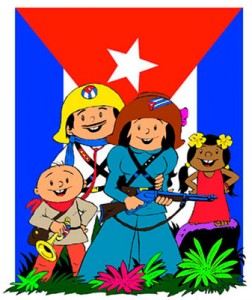Serious but Hilarious Cuban Cartoons
Osmel Almaguer

“Elpidio Valdes” constitutes one of the classics of Cuban animated film. His creator, Juan Padron, is perhaps one of the most important of all the masters of that art form.
It’s said that Elpidio is Cuba’s equivalent of Superman, and I don’t doubt it since it wouldn’t be the only instance. A similar case can be found in the series “Mafalda,” (by Argentine cartoonist Joaquín Salvador Lavado) a precocious child who plays the leading role in a succession of ingenious voyages in which the ways of the world and imagination are questioned — from the perspective of a child — as he and his companions prevail after complicating and then resolving conflicts.
In the case of Juan Padron, he also has to his credit the most important, enjoyed and serious animated feature film in the history of the Cuban cinema: Vampiros en la Habana (Vampires in Havana).
In that work we find action, misunderstandings and local customs mixing in a plethoric concoction of beloved characters placed in a fantastic dimension, contradicting with an almost surrealist film: the history of vampires in the tropical Caribbean.
Most recently, Padron has begun to make inroads in the making of music videos, also animated. His first attempt was selected by Proyecto Lucas (a video awards body) as being among the three best videos produced in the period between 1991 and 2006.
Nonetheless, this “father of the Cuban cartoons” doesn’t have a monopoly in terms of quality. A new generation is emerging who are somehow heirs of that flower pollinated by Padron with his creations.
Most of the titles I don’t remember, and perhaps I can’t even come up with the names of the directors of those videos, but what I do recall is a series of “muñes” (cartoons) that impressed me while at the same time making me laugh.
Most of them are theme based. They take advantage of a specific incident to teach history in an amusing way or to question an aspects of current Cuban society. They will even leave ethical messages without falling into the trap of preachy moralizing.
However there are also another type of animated Cuban films that I also don’t find convincing: one’s in which sermons prevail, with characters that are so solemn and correct that they lose all humor despite attempts by the script writers to place them in comical situations.
These were the progeny of the first cartoons after the revolution, when the ideological parameters were incomparably even more closed than they are today. “Pin Pin,” “Guaso y Carburo,” “Chuncha,” “Cecilín y Coti” and “El Captan Plin” have entered into the history of Cuban animation not because of the indulgence they provoked, but for a perseverance that has much to do with the government’s interests.
In them the pure categories of good and bad are embodied in the struggle of the main characters against criminals, in a desire — while not despicable, clearly mistaken in its approach — to contribute to a more just, conscious and safe society.





